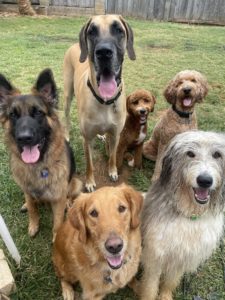If you find yourself saying ‘I just wish my dog would pay attention to me more’ try these simple tips to help. Bonus, keep in mind #6 when you OR your dog are learning anything new.

- Engage with your dog
Your dog knows when you are not paying attention. I will often tell students, “if you are not engaging with your dog, why in the world would your dog engage with you?” What do I mean by engage with your dog?
Talk to your dog on your walks or when you are out and about. Yep, be that crazy dog owner who tells your dog about your day, praise your dog for walking next to you and paying attention to you.
Make your walks unpredictable to keep your dog guessing where your next move will be. For example, if I am walking a dog, I will randomly turn to the left or right. I will
also take my dog on different walking routes even if it’s simply walking across the street.
Reward your dog for checking in on you with a tasty treat or verbal praise.
Ask your dog for various behaviors such as ‘look’, ‘sit’, ‘down’, ‘side’. If you unexpectedly ask your dog to do something every so often, they will look to you in eager anticipation of your next request.
Allow your dog some adjustment time in a new environment. Think of the last time you traveled to a new and exciting location. Upon arrival I bet you take the time to look at your new surroundings, to orientate yourself.
I find if I give the dog that I am working with 10 to 15 minutes on a long leash to take in the sights and smells, they are much more attentive to me during our training session. As a bonus, during our training session I’ll give them additional time to wander off and smell as a reward for working with me.
2. Practice
Learning anything new takes practice, time, and motivation. When training your dog, a new behavior always starts in your home where there are no distractions. As your dog becomes more familiar with the behavior, slowly add distractions by training in your front or back yard, on the street, or at a friend’s house, and then move to a park with more distractions and so on.
Also note, our dogs do not generalize as well as we do. For example, it takes a longer time for your dog to understand that ‘sitting’ at home means the same as ‘sitting’ at the park. The more you train in new environments the quicker your dog will respond to you in various locations.
3. Clicker training
A clicker is a reward marker. It marks the moment in time your dog is doing the correct behavior. The sound of the clicker is followed by a treat. Your dog learns:
“When I do this (insert your behavior here), I hear this (the sound of the clicker) and receive this (insert type of treat here).”
I find the clicker creates a thinking dog. I find dogs pay attention to me more in hopes of hearing the clicker and receiving their reinforcement; a dog that offers various behaviors in hopes of hearing the click to receive their reinforcement. Using the clicker can increase your dog’s attention to you by expecting them to pay attention to you longer before clicking. While training this, be realistic. Do not go from them glancing at you clicking and treating to hoping they look at you for 10 seconds before clicking and treating. It will take time to work up to longer amounts of time for them paying attention.
4. Have expectations at home
Let me remind you of this. If you do not expect things from your dog at home where there are no distractions, they surely are not going to pay attention to you when you are in an area that is new or with many distractions. Just like with children, if you do not encourage them to mind their manners in your home, they will not mind their manners when they are out and about in new exciting environments.
Your expectations at home can be as simple as sitting before you feed your dog or let them out the door or asking them to ‘go settle’ when you or friends walk through the door. The more you engage with your dog in less distracting areas the greater likelihood they will look to you for direction when in a distracting environment.
5. Train “LOOK” or “WATCH ME”
This is a great exercise to help redirect your dog’s attention in distracting situations. With proper training and practice, in various situations you can snap your dog’s focus onto you really quick with a simple ‘look’.
To learn how to train ‘look’ go here.
6. Have patience
Consistency over time gets results. That I know for sure!






